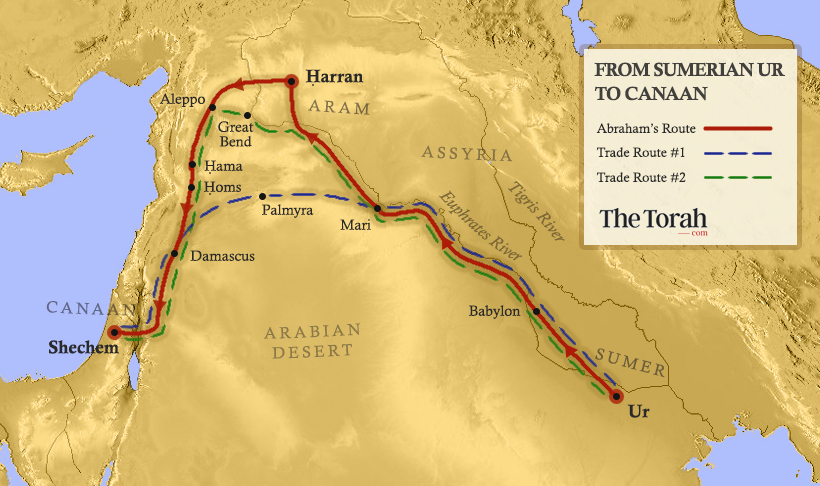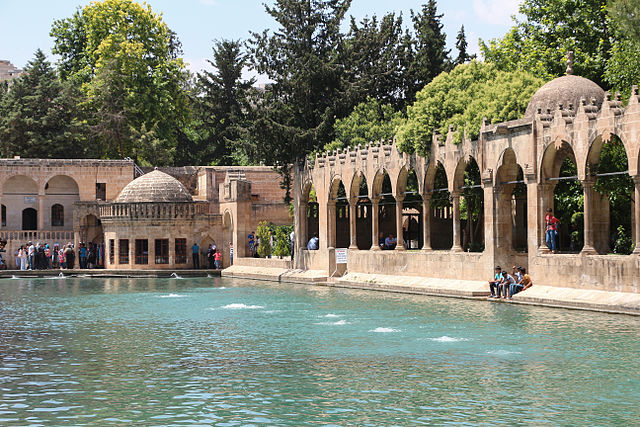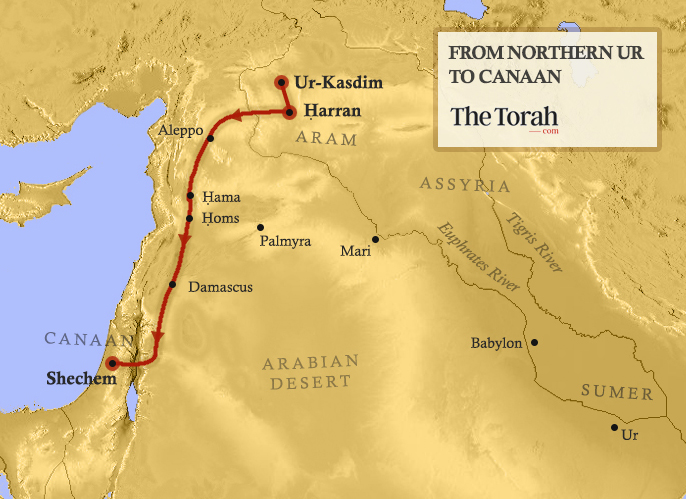 Edit article
Edit articleSeries
Ur Kasdim: Where Is Abraham’s Birthplace?

Şanlıurfa/Urfa skyline, 2006. Damien Halleux Radermecker Wikimedia. cc 2.0
Abram’s Departure from Ur
The scene in which Abram is first introduced to the reader—a genealogical record about his father Teraḥ—tells us the name of his hometown:
בראשית יא:כז וְאֵ֙לֶּה֙ תּוֹלְדֹ֣ת תֶּ֔רַח תֶּ֚רַח הוֹלִ֣יד אֶת־אַבְרָ֔ם אֶת־נָח֖וֹר וְאֶת־הָרָ֑ן וְהָרָ֖ן הוֹלִ֥יד אֶת־לֽוֹט׃ יא:כח וַיָּ֣מָת הָרָ֔ן עַל־פְּנֵ֖י תֶּ֣רַח אָבִ֑יו בְּאֶ֥רֶץ מוֹלַדְתּ֖וֹ בְּא֥וּר כַּשְׂדִּֽים׃
Gen 11:27 And these are the generations of Teraḥ. Teraḥ begot Avram, Naḥor, and Haran; and Haran begot Lot. 11:28 And Haran died before Teraḥ his father, in the land of his birthplace, in Ur-Kasdim (ʾur kaśdim, “Ur of the Chaldeans”).
After a brief notice about Abram and Nahor’s marriages, the text, without offering a reason, explains that Terah moved his family out of Ur:
בראשית יא:לא וַיִּקַּ֙ח תֶּ֜רַח אֶת־אַבְרָ֣ם בְּנ֗וֹ וְאֶת־ל֤וֹט בֶּן־הָרָן֙ בֶּן־בְּנ֔וֹ וְאֵת֙ שָׂרַ֣י כַּלָּת֔וֹ אֵ֖שֶׁת אַבְרָ֣ם בְּנ֑וֹ וַיֵּצְא֙וּ אִתָּ֜ם מֵא֣וּר כַּשְׂדִּ֗ים לָלֶ֙כֶת֙ אַ֣רְצָה כְּנַ֔עַן וַיָּבֹ֥אוּ עַד־חָרָ֖ן וַיֵּ֥שְׁבוּ שָֽׁם׃
Gen 11:31 And Teraḥ took Avram his son, and Lot the son of Haran, the son of his son, and Saray his daughter-in-law, the wife of Avram his son; and they went-out with them from Ur-Kasdim to go to the land of Canaan, and they came until Ḥarran, and they dwelt there.
The name of Abraham’s hometown is mentioned again in the opening to the Covenant between the Parts (ברית בין הבתרים), when God says to Abram:
בראשית טו:ז וַיֹּ֖אמֶר אֵלָ֑יו אֲנִ֣י יְ־הוָ֗ה אֲשֶׁ֤ר הוֹצֵאתִ֙יךָ֙ מֵא֣וּר כַּשְׂדִּ֔ים לָ֧תֶת לְךָ֛ אֶת־הָאָ֥רֶץ הַזֹּ֖את לְרִשְׁתָּֽהּ׃
Gen 15:7 I am YHWH who brought you forth from Ur-Kasdim, to give to you this land [sc. Canaan], to inherit it.
This claim is echoed in the prayer recited by the Levites in the book of Nehemiah (part of which is recited in the Jewish daily morning prayers):
נחמיה ט:ז אַתָּה־הוּא֙ יְ־הוָ֣ה הָאֱלֹהִ֔ים אֲשֶׁ֤ר בָּחַ֙רְתָּ֙ בְּאַבְרָ֔ם וְהוֹצֵאת֖וֹ מֵא֣וּר כַּשְׂדִּ֑ים וְשַׂ֥מְתָּ שְּׁמ֖וֹ אַבְרָהָֽם׃
Neh 9:7 You are YHWH God, who chose Avram, and you brought him out of Ur of the Chaldeans; and you changed his name to Avraham.
Again, the text credits Abraham’s leaving Ur-Kasdim to God, and it speaks as if Abraham went straight from there to Canaan. The account in Genesis 11, however, provides a slightly different story with some additional details. According to this pericope, Abram’s father Teraḥ, for an unspecified reason, heads to Canaan, taking with him his son Abram, his daughter-in-law Saray, and his orphaned grandson Lot.
Moreover, this journey does not take them forthwith to Canaan. Instead, when the group reaches Ḥarran, they interrupt their journey and dwell there; Teraḥ dies in that city and never ventures to Canaan (Gen 11:32). Abram himself, accompanied by Saray and Lot, will arrive in Canaan in the next chapter, after God specifically tells him to leave Ḥarran and go to the land that God will show him.
Ḥarran is a city in southeastern Turkey, 16 kilometers north of the Turkish-Syrian border; it is still called by that name today. The city is well known from cuneiform sources, in both Eblaite and Akkadian, reaching back to the 3rd millennium B.C.E., and continuing through the 2nd and 1st millennia B.C.E. as well.[1]
But where is Ur-Kasdim?
Ur in Southern Mesopotamia (Woolley)
The most common identification of Ur-Kasdim is with the great city of Ur in southern Mesopotamia (located at modern Tell el-Muqayyar in southern Iraq), which flourished especially during Sumerian times. This identification was first proposed by Henry C. Rawlinson (1810–1895),[2] but Sir Leonard Woolley (1880‒1960) was the one who established it as standard doctrine.[3]
Woolley excavated the site during the years 1922‒1934, where he uncovered one of the largest cities of the ancient world, replete with the great ziggurat, beautiful gold objects, and thousands of cuneiform tablets.[4] Woolley assumed, given the spirit of the time, including an effort to uncover biblical connections, that Abraham must have come from as great a city as Ur of Sumer.[5]
Moreover, this appeared to fit with the term Ur-Kasdim, “Ur of the Chaldees.”[6] We know that the Chaldeans were indeed resident in southern Mesopotamia during the 1st millennium B.C.E., and in fact the terms Babylonia and Chaldea become virtually interchangeable during the 7th and 6th centuries B.C.E., including during the reign of Nebuchadnezzar II.[7]
The identification of the birthplace of Abraham with Ur of Sumer in southern Iraq is standard teaching, present in almost all introductory textbooks of the Bible and the ancient Near East. Even the Vatican made this assumption when Pope John Paul II visited Ur in southern Iraq, believing it to be the birthplace of Abraham.[8] There are several problems with this identification, though.
Beyond the River?
First, Joshua 24 describes Teraḥ as living בְּעֵבֶר הַנָּהָר bə-ʿevɛr han-nahar “beyond the River.”
יהושע כד:ב כֹּה אָמַר יְ־הוָה אֱלֹהֵי יִשְׂרָאֵל בְּעֵבֶר הַנָּהָר יָשְׁבוּ אֲבוֹתֵיכֶם מֵעוֹלָם תֶּרַח אֲבִי אַבְרָהָם וַאֲבִי נָחוֹר וַיַּעַבְדוּ אֱלֹהִים אֲחֵרִים. כד:ג וָאֶקַּח אֶת אֲבִיכֶם אֶת אַבְרָהָם מֵעֵבֶר הַנָּהָר וָאוֹלֵךְ אוֹתוֹ בְּכָל אֶרֶץ כְּנָעַן...
Josh 24:2 Thus said YHWH, the God of Israel: In olden times, your forefathers—Terah, father of Abraham and father of Nahor—lived beyond the River and worshiped other gods. 24:3 But I took your father Abraham from beyond the River and led him through the whole land of Canaan…[9]
In the Bible, when the phrase ‘beyond the River’ appears without further designation, it refers to the Euphrates River.[10] But the Sumerian city of Ur is not “beyond the Euphrates,” but rather on the Euphrates, and on its western side, thus not “beyond” it from the perspective of Israel. In theory, Joshua 24 could be referring to Ḥarran, which is north of the Euphrates River, but recall that this city was simply a way-station, as it were, on the journey from Ur-Kasdim to Canaan.
Furthermore, the implication of the phrase בְּעֵבֶר הַנָּהָר יָשְׁבוּ אֲבוֹתֵיכֶם מֵעוֹלָם “your forefathers dwelt beyond the River in olden times” implies that the original homeland, which was Ur-Kasdim according to Genesis 11 and 15, was also beyond the Euphrates. In light of all this, Sumerian Ur cannot be the referent, as it is on the same side of the Euphrates as Canaan.
Ḥarran is the Wrong Direction
Moreover, a serious geographical problem plagues the story: a journey from Ur to Canaan would not pass through Ḥarran. We know the trade-routes. Anyone travelling from Ur of Sumer to Canaan would first have traveled upstream on the Euphrates, since no one would travel due west from Ur in southern Mesopotamia through the Arabian desert; even with camels the journey would be too arduous and too dangerous to allow such a crossing.
Instead, people on such a journey either would stop at Mari and then head west across the Syrian Desert, using the great oasis of Palmyra as the way-station before reaching Damascus, or they would continue further north along the Euphrates, to the Great Bend (location of present-day Lake Assad, created by the presence of the Tabqa Dam), and then head west and south via such cities as Aleppo, Ḥama, Ḥoms, etc., en route to Damascus, from which it was a relatively easy jaunt to Canaan.
But this is not what Teraḥ and family do, according to those who would identify Ur-Kasdim with Ur of Sumer in modern-day southern Iraq. These scholars would have one believe that, rather than heading towards Canaan, Terah and company instead continue north (the wrong [!] direction), by traveling upstream on the Baliḫ River, one of the tributaries of the Euphrates, to reach Ḥarran. If Ḥarran was not the destination, but rather only a way-station on the route from Ur to Canaan (as per Gen 11:31), it makes little or no sense for Teraḥ to have gone there.

Urfa in Turkey (Gordon)
One scholar who noted these problems, and disagreed with Woolley’s identification, was Cyrus Gordon (1908–2001). Although, Gordon dug with Woolley at Ur in the 1930s,[11] he could not accept the great archaeologist’s conclusion. Instead, he noted that if Teraḥ and family left Ur-Kasdim to travel to Canaan, but stopped en route in Ḥarran, then the location of Ur-Kasdim should be to the north of Ḥarran.
Considering these data points, a more attractive suggestion is that Abraham’s hometown is the city of Ur in northern Mesopotamia = modern-day Urfa in southeastern Turkey, 44 km north of Ḥarran.[12] Most likely, this city is the one mentioned as Ura in cuneiform tablets from Ugarit (14th–13th centuries B.C.E.), where it is associated with the Hittite realm.[13] A journey from Urfa to Canaan would indeed pass directly through Ḥarran.

Local (Turkish) Jewish, Christian, and Muslim tradition identifies this city as biblical Ur, the birthplace of Abraham. In fact, this notion was commonly accepted in 19th-century biblical scholarship. For example, George Bush (1796‒1859),[14] a leading biblical scholar of the day, noted regarding biblical Ur-Kasdim:
As to the city here mentioned, some difficulty has been experienced by commentators in fixing its site, but in the East it is generally identified with the present town of Orfah in Upper Mesopotamia Two days’ journey east of the Euphrates, sixty-seven miles north-east of Beer. The Jews, according to Mr. Wolff, still call the place by the name in the text, אור כשדים Oor Kasdim, or Ur of the Chaldees, and it is a place of pilgrimage as the birth-place of Abraham, in whose honour the Moslems have a fine mosque in the court of which is a lake teeming with fish which are held sacred to the patriarch’ and not permitted to be caught.[15]
Notably, the names of Teraḥ’s father Naḥor and his grandfather Serug are actually the names of cities in the general region of Urfa: a) Naḫur, known from Akkadian sources (even if its precise location in upper Mesopotamia is unknown), and b) Serug, well known from later Syriac sources, whose name persists in modern Turkish Suruç, 46 km southwest of Urfa.

The Chaldeans of Northern Mesopotamia
How, then, does one explain the latter part of the expression, namely Kasdim? As noted, the Chaldeans lived in southern Mesopotamia, but they were not native to the land, having migrated there in the early to mid-first millennium B.C.E.
Where were they from before that? The most likely answer is northern Mesopotamia. The best evidence comes from the Greek historian Xenophon (431–354 B.C.E.), who mentions the Chaldeans as a warlike people blocking the way to Armenia (Anabasis 4.3.4), and as neighbors of the Armenians but at war with them (Cyropaedia 3.1.34). Xenophon further mentions the Chaldeans in connection with the Carduchi (that is, the ancient Kurds) (Anabasis 5.5.17). In fact, to this day, the term lives on within the Chaldean Christian community, which inhabits the region.
An Aramean Area
Further support for the claim that Abraham’s hometown of Ur should be located in northern Mesopotamia comes from the Aramean connection. Deuteronomy 26:5 describes Israel’s ancestors as wandering Arameans: אֲרַמִּי אֹבֵד אָבִי “A wandering Aramean was my father”.[16] The Aramean heartland is located in northern Mesopotamia. In fact, the Bible refers to the region in which Urfa is found as Aram Naharaim, lit. ‘Aram of the Two Rivers’ (Gen 24:10, etc.), namely the Tigris and the Euphrates. Genesis 22:21‒22 juxtaposes Aram and Chesed (~ Chaldea) as scions of the family of Naḥor, suggesting their location in northern Mesopotamia in close proximity to one another.
Finally, the great Ur required no further appellation; the expression Ur of the Chaldees implies that we are not speaking of the famous city. In fact, northern Ur was likely established as a colony of the metropolis of Ur in the south and would thus naturally have been given a further appellation. A comparable case is how we say simply “London” for the great city of England, while we must state “London, Ontario” (named and founded during the years 1793‒1826) to refer to one of its outposts.
Urfa of the Chaldees
In short, various lines of evidence converge to support the tradition of the Jews, Christians, and Muslims of Turkey, as well as the scholarly arguments put forward by Bush and Gordon: Ur-Kasdim is north of Ḥarran and should be identified with the city of Urfa. Almost a century ago, Woolley pulled the wool over everyone’s eyes (sorry, I could not resist the pun) by identifying Ur-Kasdim with Ur of Sumer, even though there is no evidence in support of such a determination. Unfortunately, this identification persists in the minds of the authors who continue to produce maps, atlases, and textbooks with the erroneous information.
TheTorah.com is a 501(c)(3) nonprofit organization.
We rely on the support of readers like you. Please support us.
Published
November 6, 2019
|
Last Updated
December 3, 2025
Previous in the Series
Next in the Series
Before you continue...
Thank you to all our readers who offered their year-end support.
Please help TheTorah.com get off to a strong start in 2025.
Footnotes

Prof. Gary Rendsburg serves as the Blanche and Irving Laurie Professor of Jewish History in the Department of Jewish Studies at Rutgers University. His Ph.D. and M.A. are from N.Y.U. Rendsburg is the author of seven books and about 190 articles; his most recent book is How the Bible Is Written.
Essays on Related Topics:









